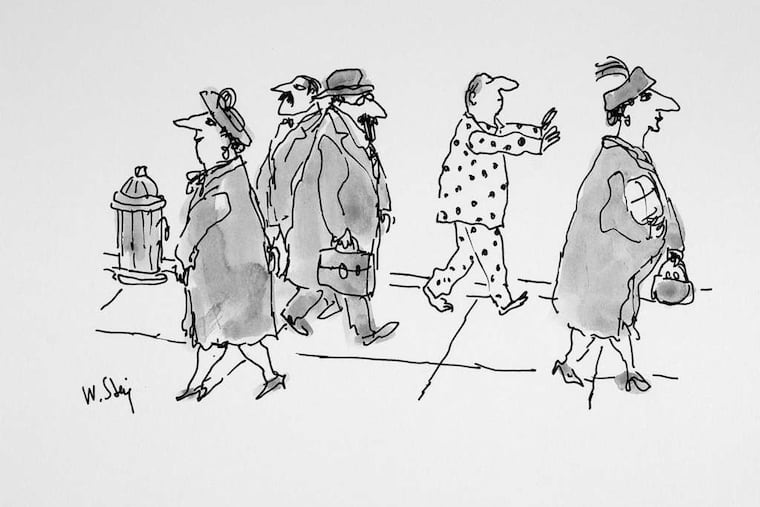A delightful walk in the world of William Steig
So astonishing is the broad range and deep humanity of William Steig's cartoons, 107 of which are now on display at the Brandywine River Museum, that they could have been mistaken momentarily for a batch of very sensitive material suddenly declassified. Instead, they're being celebrated in "Comic Catharsis: A Gift of Cartoons by William Steig."

So astonishing is the broad range and deep humanity of William Steig's cartoons, 107 of which are now on display at the Brandywine River Museum, that they could have been mistaken momentarily for a batch of very sensitive material suddenly declassified. Instead, they're being celebrated in "Comic Catharsis: A Gift of Cartoons by William Steig."
True, Steig's cartoons and cover designs appeared in the New Yorker magazine for an amazing 70 years, beginning in 1930. After such lengthy exposure - to say nothing of the huge success of his 1990 picture-book character Shrek - does the public need to see more?
Yes, as it turns out. There is plenty here to fascinate and delight.
This Brooklyn-born immigrants' son (1907-2003) was the New Yorker's first cartoonist to submit cartoons with captions; previously, the caption came first and the artist had to draw something to fit. Steig's captions ranged from whole sentences to a single word, and he soon developed a very personal cartoon style based on his learning about various states of mind - depression and anxiety, male/female relationships, competition and jealousy, self-doubt and self-importance. Crucial to this was his association with psychologist William Reich and his theories about regaining self-awareness via daily meditation as therapy to restore optimism and hope.
Recurring themes in this show, curated by Virginia O'Hara, include Steig's parade of self-absorbed city walkers of all kinds, and individuals' odd reactions to public statuary. He aimed to capture innermost thoughts along with outward behavior. A great many arguing people appear, including married couples. (Steig was divorced three times, then happily married for 30 years to his fourth wife, Jeanne, who gave these cartoons to Brandywine.)
Steig published nearly three dozen books, some of his own art but mostly children's books he both wrote and illustrated, starting at age 60. His wonderful children's themes relate to the adult ones, but with a lighter touch. Animal escapades are plentiful - the mouse who's a dentist charmed me. As a special feature, the Eric Carle Museum of Picture Book Art and private collections have loaned original Steig children's drawings for this don't-miss-it show.
Three from the studio
Seldom is a highly individualistic established painter asked to curate an art show. But it happens, thus "There's a Place," guest-curated by Philadelphia painter Sarah McEneaney at Bucks County Community College. While the artists she chose teach art locally, it wasn't a factor, as so many do; more important to her was that "all three artists have strong studio practices."
Eleanor Bystrom's large paintings, rich in color changes and surface workings, represent an impressive project she has taken on: visual recollections of her grandparents' I.M. Pei-influenced Colorado home. One image jousts a little with its dizzying space, in a rakish view upward toward its cupola.
Daniel Gerwin is interested in "painterly space." He doesn't like painting to have standoffish limits, and uses associative materials to paint on - a framed mirror, dresser drawer, salvaged joist. What his work is supposed to do, I think, is improve painting by expanding it into an environment via semi-participation pieces, refusing to shape up its rawness, its homemade feel, its inherent funkiness. There's a slight taste of sour nectar here.
H. John Thompson is orthodox by comparison. His work is physical and includes forms of practical Bucks County construction such as roofs. There's an abruptness, a chewy discontinuity about the work that suggests he's tough enough, and doesn't really need storage lockers like that ominous Artillery Shed he's showing for the well-equipped suburban backyard.
Body awareness
"Corporeal," the five-person sculpture show at the Gershman Y by alumni fellows of the Center for Emerging Visual Artists, has a lot going for it. The poles of the exhibit belong to Ava Blitz and Maria Anasazi. Blitz, a "straight" sculptor, achieves chunky elegance with her limestone and alabaster pieces - her strong, squat
Sphinx
, and her somewhat personalized female body parts (lips, breasts). Brooke Hine's ceramics more matter-of-factly look inside the human body, shaping a heart and intestines, while Leslie Speicher's surprise is an evening dress, its pretty fabric printed with a blood-cell pattern.
Susan Benarcik, obviously gifted both in taste and dexterity, and versed in using plant materials, makes a key contribution. Yet the artist embodying the show's theme best is resourceful Anasazi, with several works using found objects - a spine attached to lots of books, pieces of felt shaped like a pair of boots and pierced by hundreds of steel nails. This show has a solid, if not wildly inventive, premise.
In the adjoining Open Lens room are Peter Prusinowski's spare and simple documentary photos from his "Trail of Hope" 143-day walk from Penn Treaty Park to Leni Lenape tribal lands in Oklahoma, an achievement inspired by one man's determination and remarkable sense of social responsibility.